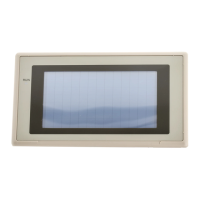3-4SectionDisplay and Control of Windows
311
Reference: When a new window is opened (when a window screen number is changed
from 0000), window open status bit of the corresponding window type in PT
status notify area goes ON. (Refer to page 312) However, when a window that
is already opened is switched (when a window screen number is changed),
window open status bit does not change.
The position on which a window is actually displayed is by 20 dot unit. When the
X coordinate is not multiple of 20 or when Y coordinate is not multiple of 20 – 1,
the specification is disregarded. (In case of moving operation, nothing is
executed. In case of opening a new window, the window is displayed at the
position that was specified when it was created.)
This rule also applies when the specification is made so that the window is go-
ing to extend out the screen boundary with the specified value.
If the specified number is not the number of a window screen, no window is
opened, and window screen number in window control area is returned to
0000, consequently, the window is closed.
Displayed window is switched when the window screen number of presently
displayed screen is changed.
2. To move the position of a presently displayed window, write the new coordi-
nate to X coordinate and Y coordinate in the window control area that corre-
sponds to the window.
The values that can be specified are same as for (1) (open).
3. To close a presently displayed window, write 0000 to window screen number
in the window control area that corresponds to the window.
Window is closed, however, X coordinate and Y coordinate retain existing
values.
Reference: When a window is closed, window open status bit of the corresponding win-
dow type in the PT status notify area goes OFF. (Refer to page 312)
When NT20S or NT30/620 compatible mode is being used, the word contain-
ing the PT status notify bits is shifted down one word. (Refer to page 451.)
Opening a Window by Setting Load Local 1 (Keyboard) or Load Local 2 Screen
Attribute
If this method is used, the specified window can be opened automatically at the
same time the screen is displayed by setting the screen number of the local win-
dow to be displayed for a screen attribute of a standard screen.
Each time the screen is switched to the one for which Load Local 1 (Keyboard) or
Load Local 2 screen attribute is set, the specified window opens.
By this method, only the local window can be opened. It is not possible to open a
global window.
When creating a screen using the Support Tool, set Load Local 1 (Keyboard) or
Load Local 2 for a screen attribute.
Reference: If the specified number is not the number of a window screen, no window opens.
Operation
1, 2, 3... 1. Switch to a screen for which Load Local 1 (Keyboard) or Load Local 2 screen
attribute is set.
2. The set window opens. The window is opened by the size and at the position
that was specified when it was created.
Setting

